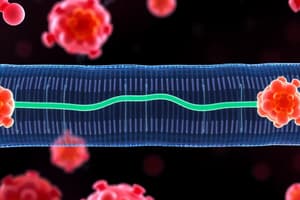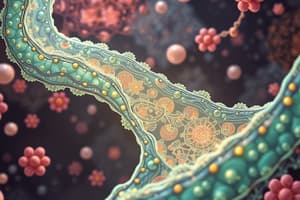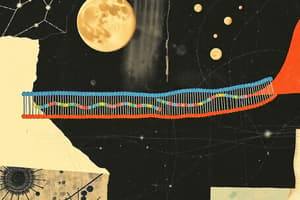Podcast
Questions and Answers
Which type of transport requires energy to move drugs across membranes?
Which type of transport requires energy to move drugs across membranes?
- Active transport (correct)
- Passive diffusion
- Filtration
- Facilitated diffusion
The primary factor influencing passive diffusion of a drug is its:
The primary factor influencing passive diffusion of a drug is its:
- Solubility in water
- Degree of ionization (correct)
- Presence of carrier proteins
- Molecular weight
What does the term bioavailability refer to?
What does the term bioavailability refer to?
- The amount of drug absorbed by the body (correct)
- The rate at which a drug is eliminated
- The concentration of the drug in the bloodstream
- The effectiveness of a drug compared to another
According to Henderson-Hasselbalch’s equation, what does a higher pH indicate for a weak acid?
According to Henderson-Hasselbalch’s equation, what does a higher pH indicate for a weak acid?
What is the primary course of drug concentration after administration in relation to the first-pass effect?
What is the primary course of drug concentration after administration in relation to the first-pass effect?
Which factor is NOT a major influence on the absorption of a drug?
Which factor is NOT a major influence on the absorption of a drug?
Which transport mechanism does NOT involve a concentration gradient?
Which transport mechanism does NOT involve a concentration gradient?
Which of the following statements about pKa is true?
Which of the following statements about pKa is true?
What happens to weak acids in acidic pH environments?
What happens to weak acids in acidic pH environments?
Which statement is true regarding the effect of pH on drug ionization?
Which statement is true regarding the effect of pH on drug ionization?
How is the degree of ionization of a drug affected by pKa and pH?
How is the degree of ionization of a drug affected by pKa and pH?
What is the relationship between pKa and the strength of an acid?
What is the relationship between pKa and the strength of an acid?
What occurs to drug absorption when moving from the stomach to the intestine?
What occurs to drug absorption when moving from the stomach to the intestine?
Why is a drug more available for absorption when it is completely unionized?
Why is a drug more available for absorption when it is completely unionized?
In which of the following pH environments would a weak base be ionized?
In which of the following pH environments would a weak base be ionized?
What is the impact of drug ionization on its absorption in the gastrointestinal tract?
What is the impact of drug ionization on its absorption in the gastrointestinal tract?
What happens to weak acids in an acidic pH environment?
What happens to weak acids in an acidic pH environment?
Why are acidic drugs ion trapped in a basic pH environment?
Why are acidic drugs ion trapped in a basic pH environment?
How does the ionization of aspirin affect its absorption in the stomach?
How does the ionization of aspirin affect its absorption in the stomach?
What characteristic is true about strong acids and bases at standard pH?
What characteristic is true about strong acids and bases at standard pH?
What is the primary difference between facilitated diffusion and active transport?
What is the primary difference between facilitated diffusion and active transport?
What occurs when barbiturates reach alkaline urine?
What occurs when barbiturates reach alkaline urine?
What does the concept of 'ion trapping' refer to in pharmacology?
What does the concept of 'ion trapping' refer to in pharmacology?
What limitation is associated with carrier-mediated transport systems?
What limitation is associated with carrier-mediated transport systems?
What term is used when formulations are not bioequivalent?
What term is used when formulations are not bioequivalent?
Which factor enhances the speed of drug absorption when taken in solution or powder form?
Which factor enhances the speed of drug absorption when taken in solution or powder form?
What is the effect of amorphous drugs compared to crystalline drugs?
What is the effect of amorphous drugs compared to crystalline drugs?
Which of the following factors can cause reduction in bioavailability due to drug metabolism?
Which of the following factors can cause reduction in bioavailability due to drug metabolism?
What condition can lead to a significant change in drug absorption due to altered gastrointestinal function?
What condition can lead to a significant change in drug absorption due to altered gastrointestinal function?
How does the presence of food in the gastrointestinal tract affect drug bioavailability?
How does the presence of food in the gastrointestinal tract affect drug bioavailability?
What type of drug substance tends to dissolve quicker due to the absence of water molecules?
What type of drug substance tends to dissolve quicker due to the absence of water molecules?
Which of the following factors is a pharmacological consideration affecting bioavailability?
Which of the following factors is a pharmacological consideration affecting bioavailability?
What defines the central compartment in pharmacokinetics?
What defines the central compartment in pharmacokinetics?
Which of the following describes a characteristic of the peripheral compartment?
Which of the following describes a characteristic of the peripheral compartment?
What happens during the elimination phase of a one-compartment model?
What happens during the elimination phase of a one-compartment model?
What is true about the distribution of a drug in a one-compartment model?
What is true about the distribution of a drug in a one-compartment model?
Which drug is known to accumulate in skeletal muscle and organs like the heart?
Which drug is known to accumulate in skeletal muscle and organs like the heart?
What is a significant function of plasma protein binding for drugs?
What is a significant function of plasma protein binding for drugs?
Which of the following substances is known to form complexes with bone salts?
Which of the following substances is known to form complexes with bone salts?
How are drugs absorbed into the peripheral compartment?
How are drugs absorbed into the peripheral compartment?
Flashcards are hidden until you start studying
Study Notes
Membrane Transport
- Passive Diffusion: Does not require energy; moves from a higher concentration to a lower concentration.
- Facilitated Diffusion: Does not require energy; moves from a higher concentration to a lower concentration using carrier proteins.
- Active Transport: Requires energy (ATP); moves from a lower concentration to a higher concentration using carrier proteins.
- Endocytosis: A process where a cell engulfs material from its surroundings.
- Filtration: A process where fluids and small molecules are pushed through a membrane.
Passive Diffusion
- Key factors affecting passive diffusion:
- Lipophilicity: A drug's ability to dissolve in fats and oils; more lipophilic drugs cross membranes more easily.
- Degree of Ionization: The extent to which a drug is ionized; non-ionized drugs are generally more lipophilic and cross membranes easier.
- pH of surrounding environment: pH affects the degree of ionization of drugs, impacting membrane permeability.
- pKa: Dissociation constant of a drug; determines the pH at which a drug is 50% ionized and 50% non-ionized.
- Henderson-Hasselbalch equation: Used to calculate the pH of a solution and predict the degree of ionization of a weak acid or weak base.
Implications of Passive Diffusion and Ionization
- Strong acids and bases: Generally stay ionized at standard pH, making it difficult for them to cross cell membranes.
- Weak acids: Are mostly non-ionized in acidic environments (e.g., stomach) and mostly ionized in basic environments (e.g., intestines).
- Weak bases: Are mostly non-ionized in basic environments (e.g., intestines) and mostly ionized in acidic environments (e.g., stomach).
- Ion Trapping: When a drug is trapped on one side of a membrane due to a difference in pH; for example, an acidic drug will be trapped in a basic environment and a basic drug will be trapped in an acidic environment.
Carrier-Mediated Transport
- Facilitated Diffusion (Carrier-mediated): No energy required, moves from higher to lower concentration, carrier proteins specific for certain drugs.
- Active Transport (Carrier-mediated): Requires energy, moves from lower to higher concentration, carrier proteins specific for certain drugs.
- Competition between drugs: Two drugs can compete for the same carrier protein, potentially leading to reduced absorption or bioavailability.
Factors Affecting Absorption and Bioavailability
-
Pharmaceutical Factors:
- Particle Size: Fine particles (e.g., powders) are absorbed faster than larger particles (e.g., tablets, capsules).
- Crystal Form: Amorphous forms dissolve faster than crystalline forms.
- Water of Hydration: Anhydrous forms dissolve faster than hydrated forms.
- Excipients/Additives: These can affect the dissolution rate and absorption of the drug.
- Degree of Ionization/Lipophilicity: Influence how easily a drug can cross cell membranes.
-
Pharmacological Factors:
- First-pass Effect/ Presystemic Elimination: Metabolism of a drug in the gut and liver before it reaches systemic circulation.
- Gastrointestinal Emptying Time: The rate at which the stomach empties into the intestines.
- Gastrointestinal Diseases: Conditions affecting the gut can impact drug absorption.
- Presence of Food/ Interactions with Food: Food can affect the absorption of drugs.
- Pharmacogenetic Factors: Genetic differences in drug metabolism and absorption can influence bioavailability.
First- Pass Effect
- The first-pass effect is the metabolism of a drug in the liver before it reaches systemic circulation.
- It can significantly reduce the bioavailability of drugs.
- Factors that influence the first-pass effect:
- Liver function: Liver disease can reduce metabolism and lead to increased bioavailability.
- Dosage form: The way a drug is administered (e.g., oral, IV) can impact the first-pass effect.
Distribution
- Describes how a drug moves from the bloodstream to various tissues and organs.
- The volume of distribution (Vd) indicates how much drug is distributed throughout the body relative to the plasma concentration.
- One-Compartment Model: The drug is considered to be equally distributed in the body.
- Two/Multi-Compartment Model: The drug can be found in different compartments (e.g., central compartment, peripheral compartments) over time.
- Distribution is often characterized by two phases:
- α phase: The rapid distribution of the drug into tissues.
- β phase: The elimination of the drug from the body.
Distribution: Drug Reservoirs
- Cellular/Tissue Reservoirs: Some drugs can accumulate in specific tissues, such as muscles, liver, heart, and kidney.
- Fat: Some lipophilic drugs can accumulate in fat tissues.
- Bones and Connective Tissues: Certain drugs can form complexes with bone salts, leading to long-term storage.
Plasma Protein Binding
- Many drugs bind to plasma proteins, such as albumin.
- This binding is reversible.
- Only unbound, free drugs are therapeutically active and can cross cell membranes.
- Protein binding can affect distribution, metabolism, and elimination.
Pharmacokinetic Interactions
- Interactions between drugs can affect the way they are absorbed, distributed, metabolized, and eliminated.
- Example: Co-administration of two drugs that compete for the same binding site on plasma proteins can alter the free drug concentrations of both drugs.
Studying That Suits You
Use AI to generate personalized quizzes and flashcards to suit your learning preferences.




